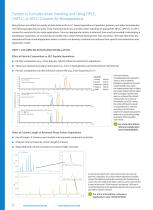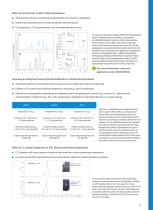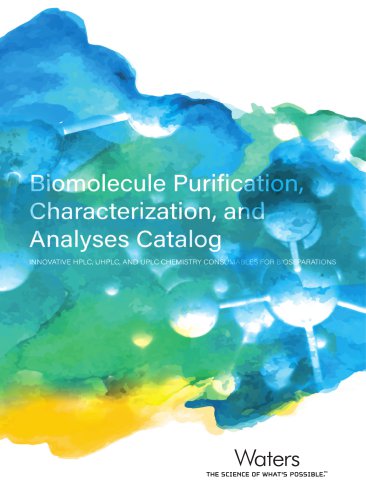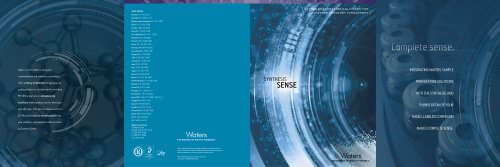
Catalog excerpts

omolecule Purification, + Characterization, ar.d^^ Analyses Catalog * INNOVATIVE HPLC, UHPLC, AND UPLC CHEMISTRY CcSSm JLES FOR B!Osi>ARATIONS
Open the catalog to page 1
Biomolecule Purification, Characterization, and Analysis Innovative Technologies from the Leader in Separation Science and Analytical Biochemistry Advances in the areas of genomics, proteomics, metabolomics, and molecular and system biology continue to revolutionize the diagnosis and treatment of diseases and increase our fundamental understanding of biological processes. As a leading analytical supplier of instrumentation, software, service and support, and chemistry products, Waters is uniquely positioned to provide researchers the tools, technologies, and integrated solutions desired to...
Open the catalog to page 2
Factors to Consider when Investing and Using HPLC, UHPLC, or UPLC Columns for Bioseparations 2 Part 1: Column Selection and Installation 5 Part 2: Bioseparation Method Development Amino Acid Analysis Glycan and Glycoprotein Analysis Oligonucleotide Analysis Peptide Analysis Protein Analysis Nano-Flow and Micro-Flow LC-MS
Open the catalog to page 3
Factors to Consider when Investing and Using HPLC, UHPLC, or UPLC Columns for Bioseparations Many factors can affect the quality of data obtained from LC-based separations of peptides, proteins, and other biomolecules. The following pages list just a few of the important factors to consider when selecting an appropriate HPLC, UHPLC, or UPLC column for analytical or lab-scale applications. Once an appropriate column is selected, time must be invested in developing a satisfactory separation, so we have also included a few useful method development “tips and tricks”. We hope that these few...
Open the catalog to page 4
Effect of Particle Size on SEC Protein Separations ■■Well-packed columns containing small particles can improve a separation ■■System back pressure will increase as particle size decreases ■■Consequently, LC instrumentation can limit potential column use 0.18 A comparison of separations of Waters BEH450 SEC Protein Standard Mix (p/n: 186006842) and Intact mAb Mass Check Standard (p/n: 186006552, diluted to 1 mg/mL) on 450 Å, silica-based 8 µm (Frames A and C) and 450 Å, BEH 3.5 µm (Frames B and D) SEC columns. Both columns were the same dimensions (7.8 x 300 mm) and separations were...
Open the catalog to page 5
Importance of Making Good Connections from Column to LC System ■■Poor column-to-instrument connections can degrade a chromatographic separation ■■Perceived column leaking can also be caused by a poor connection Sources of Band Spreading – Improper Column Connection Improper Connection Dead/void volume Column tubing not seated properly – creates a void Resulting peak shape Unswept volume causing brand broadening Proper Connection Resulting peak shape Tubing flush with end-fitting and good seal Importance of Batch-to-Batch and Column-to-Column Reproducibility ■■Column reproducibility is a key...
Open the catalog to page 6
PART 2: BIOSEPARATION METHOD DEVELOPMENT Eluent Effect on SEC Peptide Separations ■■Non-desired, secondary interactions can compromise LC separations ■■Use of an appropriate LC eluent can minimize secondary interactions 25 mM sodium phosphate, pH 6.2, 250 mM sodium chloride Method development experiments evaluated the effect of mobile-phase pH and salt concentration. The results showed minimal effect of salt concentrations (150–350 mM) and mobile-phase pH (6.2–7.4) on retention time (data not shown). All of the aqueous mobile phases resulted in later than expected elution for most small...
Open the catalog to page 7
Temperature Effect on Reversed-Phase Protein Separations ■■Use of “room temperature” is NOT always the ideal separation temperature ■■Use of a column heater is strongly recommended for reproducible analyses The intact IgG sample gave no observable peak at 40 °C, but recovery for the IgG sample improves with increasing temperature. There is not a measurable increase in recovery or improvement in peak shape above 80 °C. Column temperature has a large effect on reversedphase separation of molecules. Changes in recovery and selectivity are not uncommon with small molecule separations. While...
Open the catalog to page 8
Effect of Gradient Duration of a Reversed-Phase Peptide Separation ■■Use of longer gradient time can translate into improved component resolution ■■Analysis time will increase using longer gradients as will peak volume ■■Sample complexity can influence selected gradient duration The use of salt gradients can also be used to analyze variants of a single protein. In this example, chicken albumin was analyzed by anion-exchange chromatography. Three different gradient slopes were employed to analyze the variants of albumin formed by post transitional modifications, such as methylation,...
Open the catalog to page 9
[ WATERS ONLINE ORDER CENTER ] Whether you are a lab manager, scientist, or purchasing agent in procurement, we make it easy for you to research, compare, and purchase consumables and spare parts online.
Open the catalog to page 10
Amino Acid Analysis Amino Acid Analysis 9
Open the catalog to page 11
Amino Acid Analysis
Open the catalog to page 12
Amino Acid Analysis Amino acids are the constituents of proteins and are the intermediates in many metabolic pathways. Qualitative and quantitative Amino Acid Analysis (AAA) is used to determine the concentration of proteins, identify proteins, and detect structural variants. Amino acid composition is a critical component of the nutritional value of foods and feeds. The same analytical tools are used to monitor cell culture and fermentation processes. AAA is also used as a clinical diagnostic tool for assessing inborn errors of metabolism and nutritional status. The accurate identification...
Open the catalog to page 13
ACCURATE AMINO ACID ANALYSES FROM VARIED SAMPLE MATRICES The UPLC Amino Acid Analysis Solution includes two complete methods using the same instrumentation and chemistries. The first is suitable for the amino acids derived from protein hydrolysates. The second is suitable for the larger number of free amino acids found in process samples such as cell culture or fermentation broths. The methods differ in the dilution of the AccQ•Tag Ultra Eluent A and the separation column temperature. There are no user adjustments of pH or modifications of composition for either Eluent A or Eluent B....
Open the catalog to page 14All Waters Ges.m.b.H catalogs and technical brochures
-
Preparative OBD Columns Brochure
12 Pages
-
ACQUITY UPLC M-Class
3 Pages
-
Viridis®
6 Pages
-
Trefoil™
7 Pages
-
Torus™
7 Pages
-
Protein-Pak™
6 Pages
-
Enzymate BEH Pepsin Columns
5 Pages
-
XBridge™
12 Pages
-
2432
2 Pages
-
ACQUITY UPLC I-Class PLUS
6 Pages
-
ACQUITY UPLC H-Class PLUS
6 Pages
-
ProteinWorks
6 Pages
-
HPLC Column Performance
30 Pages
-
PoraPak Rxn Brochure
8 Pages
-
Food Testing Solutions Brochure
14 Pages






























